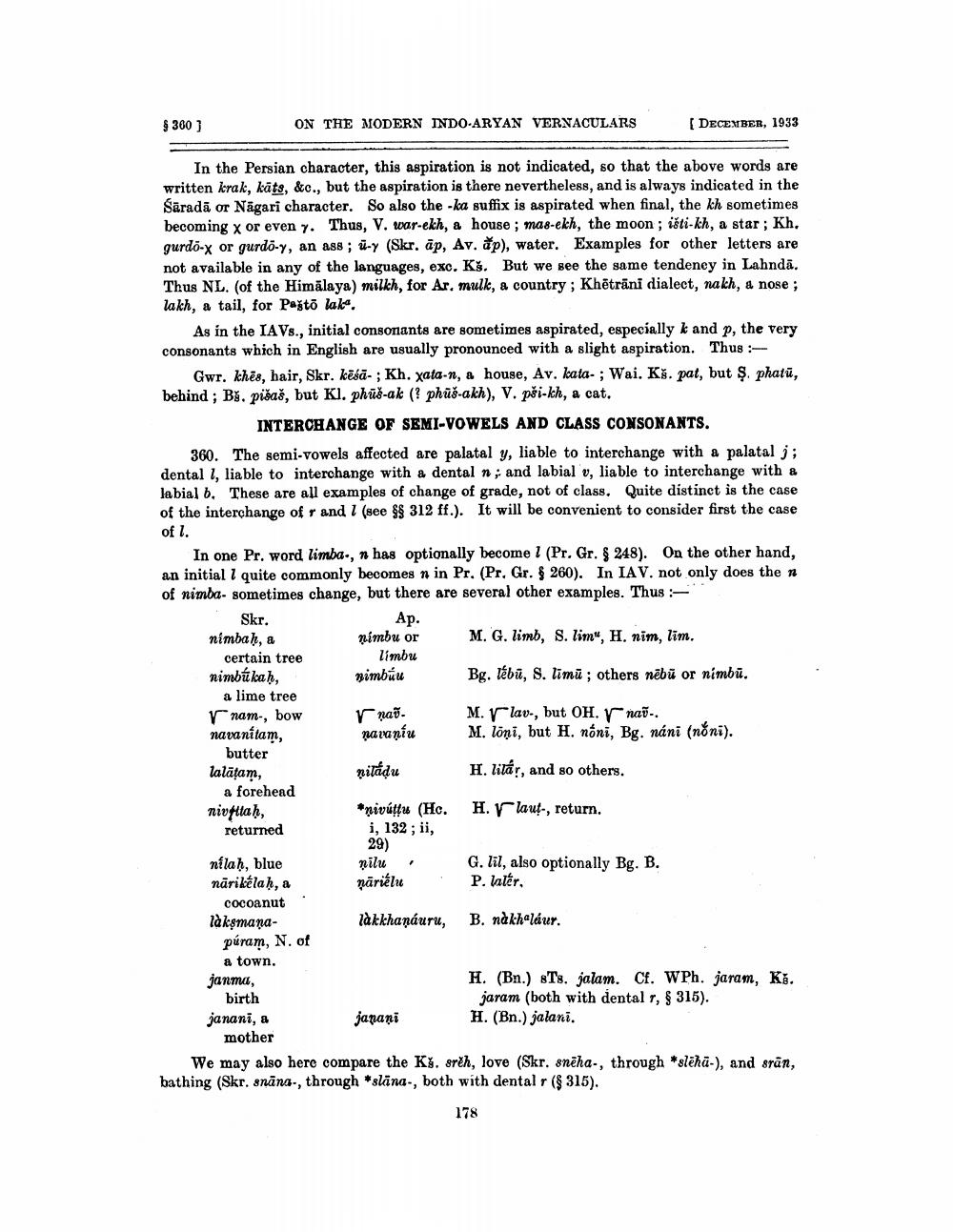________________
§ 360]
In the Persian character, this aspiration is not indicated, so that the above words are written krak, kāts, &c., but the aspiration is there nevertheless, and is always indicated in the Sarada or Nagari character. So also the -ka suffix is aspirated when final, the kh sometimes becoming x or even 7. Thus, V. war-ekh, a house; mas-ekh, the moon; išti-kh, a star; Kh. gurdo-x or gurdo-y, an ass; u-y (Skr. ap, Av. ap), water. Examples for other letters are not available in any of the languages, exc. Ks. But we see the same tendency in Lahndā. Thus NL. (of the Himalaya) milkh, for Ar. mulk, a country; Khētrāni dialect, nakh, a nose; lakh, a tail, for Paštō laka.
As in the IAVs., initial consonants are sometimes aspirated, especially k and p, the very consonants which in English are usually pronounced with a slight aspiration. Thus :
ON THE MODERN INDO-ARYAN VERNACULARS
Gwr. khes, hair, Skr. keśā-; Kh. xata-n, a house, Av. kata-; Wai. Kš. pat, but $. phatu, behind; Bš. pišaš, but Kl. phuš-ak (? phuš-akh), V. pši-kh, a cat.
INTERCHANGE OF SEMI-VOWELS AND CLASS CONSONANTS.
360. The semi-vowels affected are palatal y, liable to interchange with a palatal j; dental 1, liable to interchange with a dental n; and labial v, liable to interchange with a labial b. These are all examples of change of grade, not of class. Quite distinct is the case of the interchange of r and I (see §§ 312 ff.). It will be convenient to consider first the case of 1.
In one Pr. word limba-, n has optionally become 1 (Pr. Gr. § 248). On the other hand, an initial 7 quite commonly becomes n in Pr. (Pr. Gr. § 260). In IAV. not only does the n of nimba- sometimes change, but there are several other examples. Thus :
Ap. nimbu or limbu nimbúu
Skr. nimbaḥ, a
certain tree mimba.
a lime tree nam-, bow navalta,
butter Jalda,
a forehead
niva,
returned
nilaḥ, blue nārikelaḥ, a cocoanut
lakṣmaṇapúram, N. of
a town.
jan, birth
janani, a
mother
[DECEMBER, 1933
√ nav. navaníu
Billdu
*nivúttu (Hc.
i, 132; ii, 29)
nilu
ņāriélu
lakkhaṇáuru,
japani
M. G. limb, S. lim", H. nim, lim.
Bg. lébu, S. limu; others nebū or nimbu.
M. Vlav-, but OH.nav-.
M. loni, but H. nóni, Bg. náni (noni).
H. lilar, and so others.
H. laut-, return.
G. lil, also optionally Bg. B. P. later,
B. nakhaláur.
H. (Bn.) sTs. jalam. Cf. WPh. jaram, Kă. jaram (both with dental r, § 315).
H. (Bn.) jalani.
We may also here compare the Kš. srěh, love (Skr. sněha-, through *slehā-), and srān, bathing (Skr. snana-, through *slana-, both with dental r (§ 315).
178




